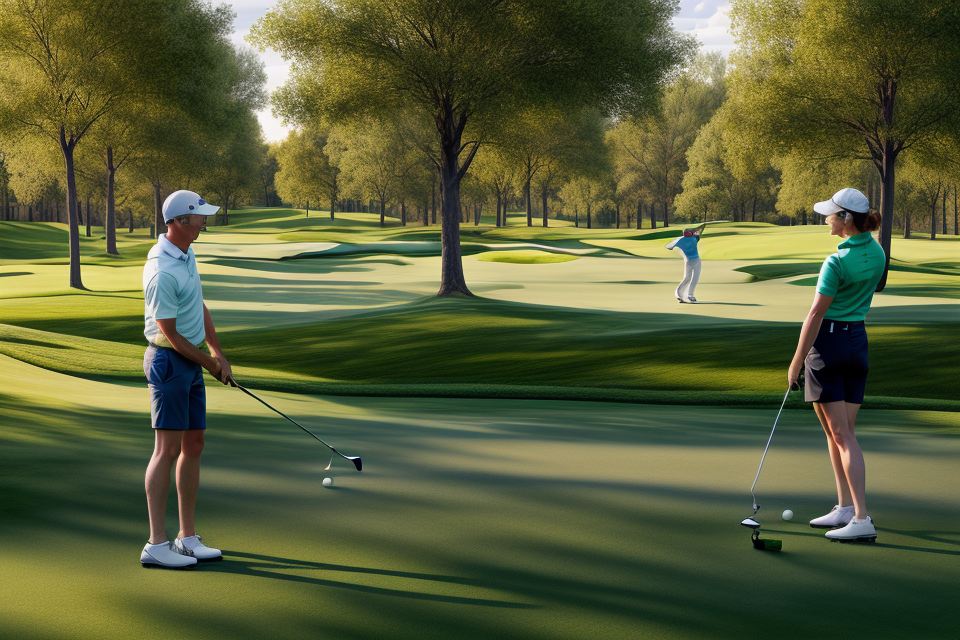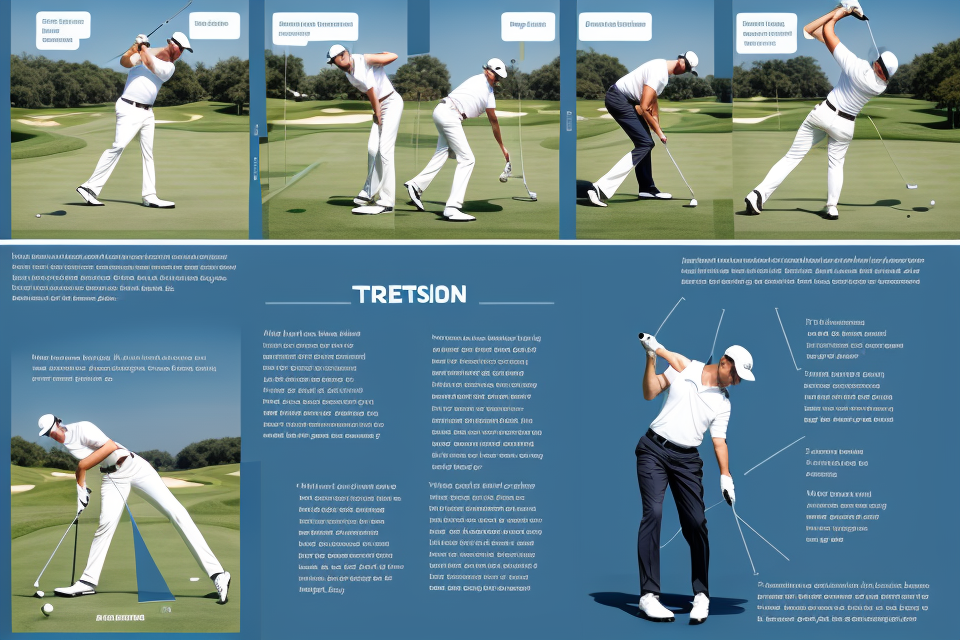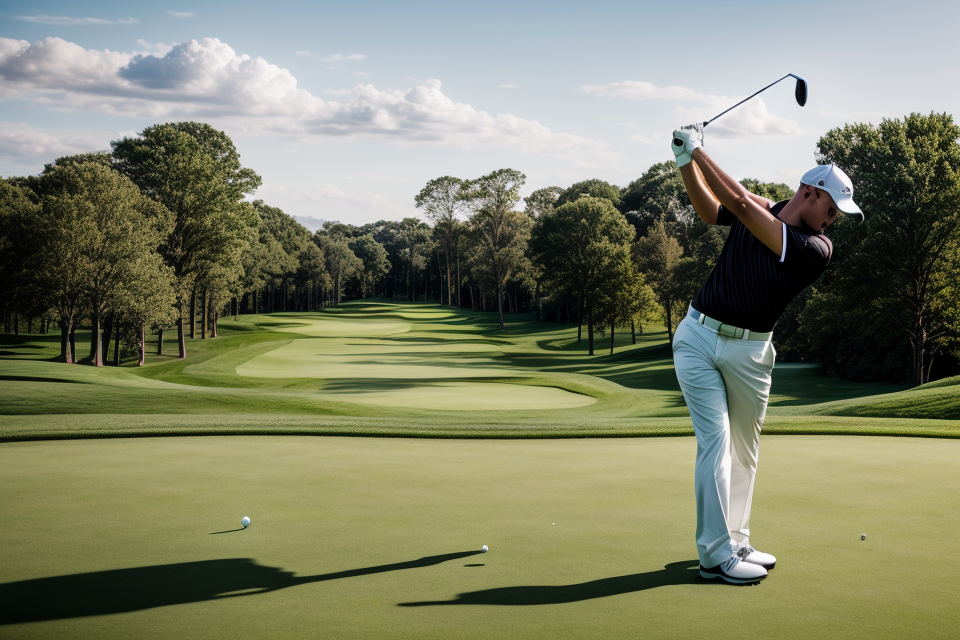
Are you new to the game of golf and feeling overwhelmed by all the rules and techniques? Don’t worry, you’re not alone! Golf can seem intimidating at first, but with a little guidance, anyone can learn how to play. In this beginner’s guide, we’ll cover the basics of golf, from the equipment you’ll need to the swing techniques that will help you succeed on the course. Whether you’re a complete beginner or just looking to brush up on your skills, this guide has got you covered. So grab your clubs and let’s get started on the fairway to golfing success!
Getting Started: The Basics of Golf
Understanding the Course
Before you step onto the golf course, it’s important to understand its layout and the hazards and obstacles that you may encounter. Here are some key things to keep in mind:
- The Teeing Ground: This is where you start each hole. It’s marked by a small white marker and is usually located near the fairway.
- The Fairway: This is the area of the course where the ball is intended to be hit. It’s typically grassy and well-maintained, and there are often fewer hazards and obstacles to contend with.
- The Green: This is the area surrounding the hole, which is typically made up of grass, sand, and other materials. The green is where you’ll aim to hit the ball into the hole.
- Hazards and Obstacles: These can include water hazards, bunkers, trees, and other natural and man-made features. It’s important to familiarize yourself with these hazards and to plan your shots accordingly.
- Golf Cart Usage: Golf carts are often used to get around the course, but it’s important to follow the rules and regulations of the course when using one. Some courses may require you to walk, while others may allow cart usage on certain parts of the course.
By understanding the layout of the course and the hazards and obstacles that you may encounter, you’ll be better prepared to play a successful round of golf.
Choosing the Right Equipment
Choosing the right equipment is an essential part of getting started with golf. It can have a significant impact on your performance on the course. Here are some things to consider when choosing your golf clubs, balls, shoes, and clothing.
- Golf Clubs: The most important piece of equipment for golf is the golf clubs. There are many different types of golf clubs, including drivers, fairway woods, hybrids, irons, wedges, and putters. Each type of club serves a different purpose and is used for different shots. It’s important to choose clubs that are the right size and weight for you, as well as clubs that have the right loft and angle for your swing.
- Balls: Golf balls come in a variety of types, including two-piece, three-piece, and four-piece balls. Two-piece balls are the most common and are designed for players with slower swing speeds. Three-piece balls are designed for players with moderate swing speeds, while four-piece balls are designed for players with faster swing speeds.
- Shoes: Golf shoes are designed to provide stability and support during your swing. They typically have spiked or soft plastic soles that allow for good traction on the golf course. Some golf shoes also have extra cushioning and support for your feet.
- Clothing: Golf clothing is designed to be comfortable and functional on the golf course. It’s important to choose clothing that allows for a full range of motion and doesn’t restrict your movement. Golf clothing typically includes a golf shirt, golf pants, and a golf hat or visor.
In summary, choosing the right equipment is crucial for a beginner golfer. Golf clubs, balls, shoes, and clothing all play a significant role in your performance on the course. It’s important to choose equipment that is the right size, weight, and type for your needs as a golfer.
Basic Golf Swing Techniques
The golf swing is a complex motion that requires precision and control. Mastering the basic techniques of the golf swing is essential for any beginner looking to succeed on the course. Here are the four key elements of the golf swing:
- Grip: The grip is the first point of contact between the golfer and the club. A proper grip involves placing the hands on the club in a way that allows for maximum control and power. The most common grip is the overlapping grip, where the pinky finger of the left hand overlaps the index finger of the right hand.
- Stance: The stance is the position of the golfer’s body in relation to the ball and the target. A proper stance involves standing with the feet shoulder-width apart, with the knees slightly bent and the weight evenly distributed on both feet. The body should be facing the target, with the shoulders squared and the arms hanging freely by the sides.
- Swing: The swing is the motion of the club as it moves through the air, from the address position to the finish position. A proper swing involves a smooth, rhythmic motion that is powered by the core muscles and the legs. The golfer should keep their head down and their eyes focused on the ball throughout the swing.
- Follow-through: The follow-through is the motion of the club after it has made contact with the ball. A proper follow-through involves continuing the swing past the point of impact, with the arms and hands continuing to rotate through the ball. This helps to maximize power and accuracy.
Mastering these basic techniques takes time and practice, but with dedication and focus, any beginner can develop the skills necessary to succeed on the golf course.
Scoring and Playing the Game
Understanding Golf Scoring
Golf scoring is an essential aspect of the game that determines a player’s performance on the course. There are three main types of golf scoring: stroke play, match play, and handicaps.
Stroke play
Stroke play is the most common form of golf scoring, and it involves counting the total number of strokes a player takes to complete a round or a specific hole. The player with the lowest total strokes at the end of the round wins. Stroke play can be played in a variety of formats, including individual stroke play, team stroke play, and best ball stroke play.
Match play
Match play is a format of golf scoring where players or teams compete against each other in a match. Each hole is played in a winner-takes-all format, and the player or team that wins the hole earns a point. The first player or team to reach a specified number of points, usually 18, wins the match. Match play is a more subjective form of golf scoring, as it relies on skill, strategy, and mental toughness.
Handicaps
Handicaps are a way of adjusting a player’s score based on their skill level and ability. Handicaps are determined by a player’s previous rounds and are used to level the playing field between players of different skill levels. Handicaps are typically expressed as a fraction or decimal, with lower numbers indicating a higher skill level.
In conclusion, understanding golf scoring is crucial for any beginner looking to improve their game and compete on the course. Whether it’s stroke play, match play, or handicaps, knowing the different types of golf scoring and how they work can help you succeed on the course.
Playing a Round of Golf
A round of golf is typically 18 holes, but it can vary depending on the course. The objective of the game is to hit the ball into the hole with the least number of strokes possible. Here are the different stages of playing a round of golf:
Teeing off
The game starts with teeing off, where the player must hit the ball from the tee box to the fairway. This is usually the longest shot of the game and requires a good technique to hit the ball straight and far.
Approaching the green
Once the player reaches the green, they must use a lower lofted club to hit the ball towards the hole. This stage requires precision and accuracy as the player must aim for the flagstick or the hole.
Putting
After approaching the green, the player must putt the ball into the hole. Putting requires a smooth and accurate stroke to roll the ball into the hole. The player must use the right amount of force and speed to make sure the ball goes in.
Chipping
Chipping is a technique used to hit the ball out of a tight lie or a difficult situation near the green. The player must use a lower lofted club to hit the ball high and softly towards the hole. This requires precision and control to avoid going over the green or into the bunker.
Overall, playing a round of golf requires patience, practice, and technique. By mastering these different stages, a beginner can improve their game and enjoy playing golf.
Golf Etiquette and Rules
Golf is a sport that is steeped in tradition and etiquette. As a beginner, it is important to understand and adhere to the rules and etiquette of the game to ensure a pleasant and enjoyable experience on the course. Here are some of the key golf etiquette and rules that you should be aware of:
On the Tee
When it is your turn to play, it is important to wait until the group in front of you has cleared the tee box before playing. This is known as “playing through,” and it is a sign of respect for your fellow golfers. It is also important to keep noise to a minimum on the tee box to avoid distracting other players.
On the Fairway
When you are on the fairway, it is important to keep your distance from other golfers and to let faster groups of players play through. If you are unable to get around a slower group of players, it is acceptable to wait until they are out of range before playing your shot. It is also important to repair any divots or ball marks on the fairway after you have finished your shot.
In the Rough
If your ball comes to rest in the rough, it is important to take a drop from the nearest point of relief that is not in a hazard or a worse area of the rough. It is also important to avoid damaging the turf in the rough by using a golf club to lift the ball out of the rough rather than digging it out with your hands.
Around the Green
When you are around the green, it is important to be mindful of other golfers who may be playing shots from nearby areas. It is also important to repair any ball marks or divots on the green after you have finished your shot. If you are playing in a group, it is customary to wait until the group in front of you has finished putting out before raking the sand or replacing the flagstick on the green.
When putting, it is important to be mindful of other golfers who may be waiting to play. It is also important to avoid slowing down the pace of play by taking too long to line up your putt or by spending too much time over each putt. If you are playing in a group, it is customary to wait until the group in front of you has finished putting out before you start putting.
Improving Your Game: Tips and Techniques
Warm-up and Stretching
Before starting your game, it is important to warm up and stretch your muscles. This will help prevent injuries and improve your performance on the course. Here are some tips for a pre-round warm-up and stretching exercises:
Pre-round Warm-up
- Start with some light jogging or walking to get your blood flowing and your muscles warmed up.
- Do some dynamic stretches, such as leg swings, arm circles, and hip rotations, to loosen up your muscles and increase your range of motion.
- Practice some short-game shots, such as chip shots and putts, to get a feel for the club and ball.
- Take some practice swings with your driver or other long clubs to get a sense of your swing speed and power.
Stretching Exercises
- Stand with your feet shoulder-width apart and extend one arm overhead while stretching the opposite leg behind you. Hold for 15-30 seconds, then switch sides.
- Kneel on one knee with the other foot out in front of you. Lean forward into a stretch, keeping your back straight, and hold for 15-30 seconds. Repeat on the other side.
- Sit on the ground with your legs extended in front of you. Reach forward and grab your toes, pulling them back towards your body. Hold for 15-30 seconds.
- Stand with your feet shoulder-width apart and lean forward, keeping your back straight, until you feel a stretch in your hamstrings. Hold for 15-30 seconds.
Remember to take your time when stretching and hold each position for at least 15-30 seconds to allow for a full stretch. Stretching before playing golf can help you avoid injuries and improve your performance on the course.
Practice Drills
Golf is a sport that requires both physical and mental skill. While playing on the course is the ultimate goal, practice is essential to improve your game. Here are some practice drills that can help you improve your full swing, short game, and putting.
Full Swing Practice
Full swing practice is important for improving your overall game. It helps you develop the correct swing mechanics and improve your distance and accuracy. Here are some practice drills to help you improve your full swing:
- Driver Swing: Stand behind the ball and use a driver to hit it as far as you can down the fairway. Focus on keeping your head down and your arms extended during the swing.
- Iron Swing: Use a set of irons to practice your swing. Start with the longest iron and work your way down to the shortest iron. Focus on making solid contact with the ball and keeping your swing smooth and consistent.
- Fairway Wood Swing: Fairway woods are similar to drivers but have a smaller head and more loft. Practice your fairway wood swing by standing behind the ball and using a fairway wood to hit it as far as you can down the fairway.
Short Game Practice
The short game is crucial for getting up and down from around the green. It involves shots from within 100 yards of the green, such as chip shots, pitches, and putts. Here are some practice drills to help you improve your short game:
- Chipping: Set up a few golf balls around the green and practice chipping them using a lofted club, such as a sand wedge or lob wedge. Focus on making solid contact with the ball and keeping your arms and shoulders relaxed during the swing.
- Pitching: Pitching is similar to chipping but involves a lower, more controlled flight. Practice pitching by standing closer to the green and using a lower lofted club, such as a pitching wedge or a gap wedge.
- Putting: Putting is the art of rolling the ball into the hole from a short distance. Practice putting by setting up a few balls on the green and using a putter to roll them into the hole. Focus on keeping your stroke smooth and consistent.
Putting Practice
Putting is one of the most important aspects of golf, as it can make or break your score. Here are some practice drills to help you improve your putting:
- Stroke Path: Practice your stroke path by setting up a few balls on the green and using a putter to roll them into the hole. Focus on keeping your stroke path consistent and avoiding any jerky movements.
- Aiming: Practice your aim by setting up a few balls on the green and using a putter to roll them into the hole. Focus on aiming correctly and making sure your putter face is square to the target line.
- Speed Control: Practice your speed control by setting up a few balls on the green and using a putter to roll them into the hole. Focus on controlling the speed of your putts and avoiding any missed putts due to incorrect speed.
By practicing these drills regularly, you can improve your game and become a better golfer. Remember to practice with patience and focus on making small improvements with each session.
Mental Game
The mental game is a crucial aspect of golf that often gets overlooked by beginners. However, developing a strong mental game can help you improve your focus, manage stress and anxiety, and visualize your shots more effectively. Here are some tips to help you develop your mental game:
Focus and Concentration
Focus and concentration are essential components of the mental game. To improve your focus, try the following tips:
- Set clear goals for each round or session.
- Eliminate distractions, such as checking your phone or listening to music.
- Use breathing exercises to calm your mind and center your thoughts.
- Practice visualization techniques to imagine your shots and their outcomes.
Managing Stress and Anxiety
Golf can be a stressful and anxiety-inducing sport, especially for beginners. However, learning to manage your stress and anxiety can help you perform better on the course. Here are some tips to help you manage stress and anxiety:
- Take deep breaths and try to relax your body.
- Focus on the present moment and avoid worrying about the future.
- Use positive self-talk to encourage yourself and build confidence.
- Try to maintain a positive attitude, even in difficult situations.
Visualization Techniques
Visualization techniques can help you improve your mental game by allowing you to imagine yourself performing well on the course. Here are some tips to help you visualize your shots:
- Close your eyes and imagine yourself making a successful shot.
- Use mental rehearsal to visualize yourself playing the hole, shot by shot.
- Practice visualizing different scenarios, such as hitting from a hazard or making a long putt.
- Try to make your visualizations as vivid and detailed as possible, using all of your senses.
By developing your mental game, you can improve your focus, manage stress and anxiety, and visualize your shots more effectively. These skills can help you perform better on the course and enjoy the game of golf more fully.
Fitness and Conditioning
To become a better golfer, it’s important to focus on your overall fitness and conditioning. Here are some tips to help you improve your physical abilities on the course:
- Exercises for golf-specific fitness: Incorporate exercises that target the muscles used in golf, such as the core, legs, and upper body. Examples include squats, lunges, planks, and rotational exercises.
- Building strength and endurance: As you progress, gradually increase the intensity and duration of your workouts to build strength and endurance. This will help you sustain your swing and improve your overall game.
- Improving flexibility and mobility: Golf requires good flexibility and mobility in the joints, particularly in the hips, shoulders, and wrists. Incorporate stretching and mobility exercises into your routine to improve your range of motion and reduce the risk of injury.
Remember, it’s important to listen to your body and start slowly. Gradually increase the intensity and duration of your workouts to avoid injury and ensure that you’re making progress towards your fitness goals. With consistent effort and dedication, you’ll be well on your way to becoming a better golfer.
FAQs
1. What is golf and how do you play it?
Golf is a sport played on a course with 18 holes. The objective of the game is to hit a small ball into a hole using a variety of clubs. The player with the lowest score wins. To play, you will need a set of golf clubs, golf balls, and golf shoes. You will also need to wear appropriate clothing for golfing.
2. How do I choose the right golf clubs?
When choosing golf clubs, it is important to consider your skill level and the type of shot you want to make. For beginners, we recommend starting with a set of clubs that includes a driver, a fairway wood, a hybrid, an iron, a wedge, and a putter.
3. How do I grip the golf club correctly?
To grip a golf club correctly, place your dominant hand on the bottom of the grip and your non-dominant hand on top. Your Vs should be pointing towards the ground and your thumbs should be wrapped around the grip. Hold the club with your palms facing the target and your arms hanging loosely by your sides.
4. How do I make a proper swing?
To make a proper swing, start by addressing the ball with your feet shoulder-width apart and your hands on the club. Slightly bend your knees and hips and lean forward from your hips. Keep your head down and eyes on the ball and use your legs, hips, and torso to power the swing. Keep your arms and hands loose and let the club do the work.
5. How do I putt in golf?
To putt in golf, approach the ball with your putter and stand behind it with your eyes on the ball. Place the putterhead behind the ball and keep your eyes on the target. Sway your body and use your hands to control the putter as you make the stroke. Keep your head down and follow through after the ball has been hit.
6. What is the etiquette on a golf course?
Golf course etiquette includes things like replacing divots, repairing ball marks, and keeping the pace of play. It is also important to be respectful of other players and to keep quiet while they are taking their shots. It is also a good idea to know the rules of the course and to follow them.
7. How do I improve my golf skills?
To improve your golf skills, it is important to practice regularly and to take lessons from a golf pro. You can also try different techniques and strategies on the course to see what works best for you. Additionally, it is important to focus on your mental game and to stay positive and focused on the task at hand.


